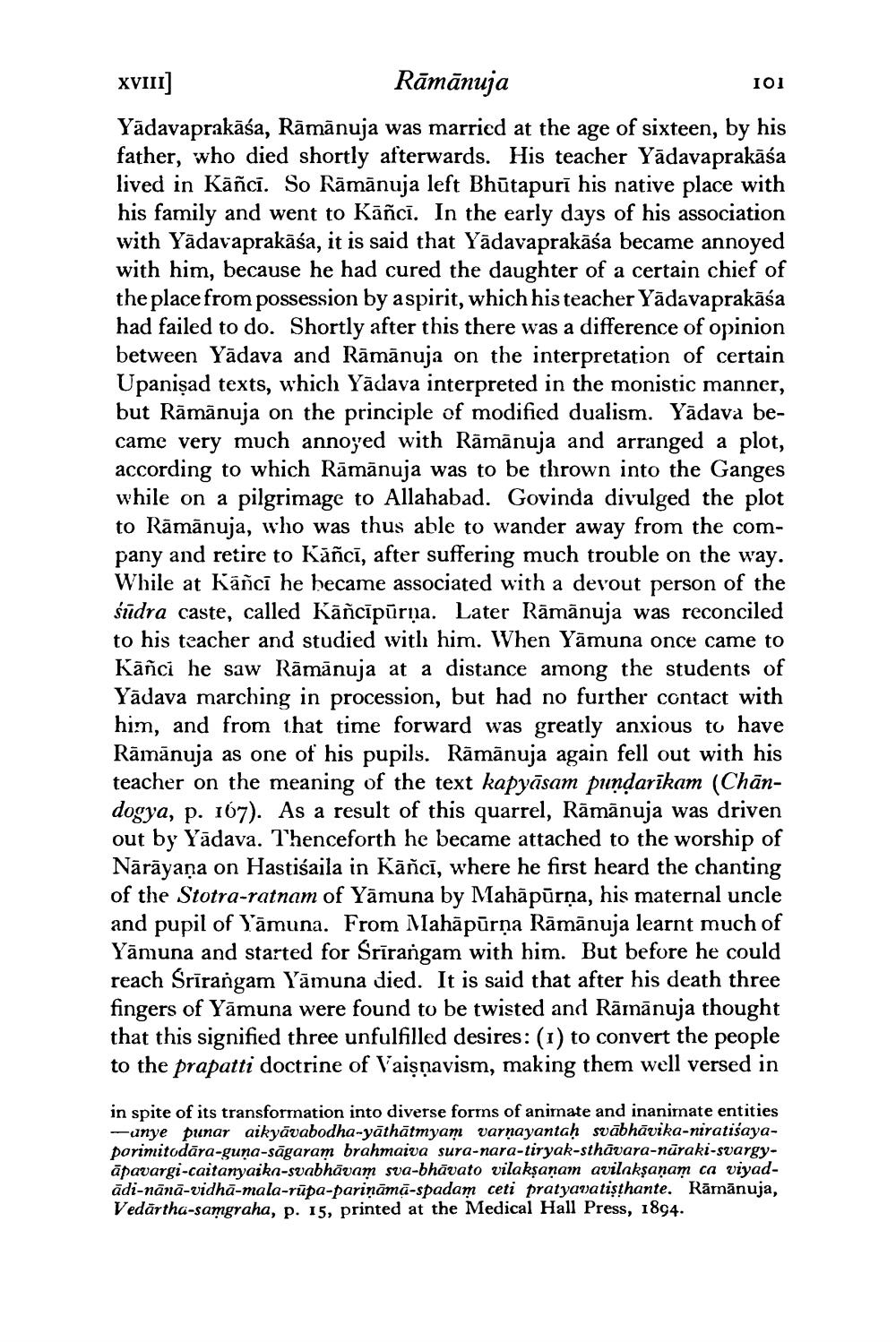________________
XVIII] Rāmānuja
101 Yādavaprakāśa, Rāmānuja was married at the age of sixteen, by his father, who died shortly afterwards. His teacher Yādavaprakāśa lived in Kāñci. So Rāmānuja left Bhūtapurī his native place with his family and went to Kāñcī. In the early days of his association with Yādavaprakāśa, it is said that Yādavaprakāśa became annoyed with him, because he had cured the daughter of a certain chief of the place from possession by aspirit, which his teacher Yādavaprakāśa had failed to do. Shortly after this there was a difference of opinion between Yādava and Rāmānuja on the interpretation of certain Upanişad texts, which Yādava interpreted in the monistic manner, but Rāmānuja on the principle of modified dualism. Yādava became very much annoyed with Rāmānuja and arranged a plot, according to which Rāmānuja was to be thrown into the Ganges while on a pilgrimage to Allahabad. Govinda divulged the plot to Rāmānuja, who was thus able to wander away from the company and retire to Kāñcī, after suffering much trouble on the way. While at Kāñcī he became associated with a devout person of the śūdra caste, called Kāñcīpūrņa. Later Rāmānuja was reconciled to his teacher and studied with him. When Yāmuna once came to Kāñci he saw Rāmānuja at a distance among the students of Yādava marching in procession, but had no further contact with him, and from that time forward was greatly anxious to have Rāmānuja as one of his pupils. Rāmānuja again fell out with his teacher on the meaning of the text kapyāsam pundarīkam (Chāndogya, p. 167). As a result of this quarrel, Rāmānuja was driven out by Yādava. Thenceforth he became attached to the worship of Nārāyana on Hastisaila in Kāñcī, where he first heard the chanting of the Stotra-ratnam of Yāmuna by Mahāpūrņa, his maternal uncle and pupil of Yāmuna. From Mahāpūrņa Rāmānuja learnt much of Yāmuna and started for Srirangam with him. But before he could reach Srirangam Yāmuna died. It is said that after his death three fingers of Yamuna were found to be twisted and Rārnānuja thought that this signified three unfulfilled desires: (1) to convert the people to the prapatti doctrine of Vaişņavism, making them well versed in
in spite of its transformation into diverse forms of animate and inanimate entities -anye punar aikyāvabodha-yathātmyam varnayantaḥ svābhāvika-niratiśayaporimitodāra-guna-sāgaram brahmaiva sura-nara-tirak-sthāvara-nūraki-svargyāpavargi-caitanyaika-svabhāvam sva-bhāvato vilakṣaṇam avilakṣaṇam ca viyadādi-nānā-vidhā-mala-rūpa-pariņāmā-spadam ceti pratyavatişthante. Rārnānuja, Vedārtha-samgraha, p. 15, printed at the Medical Hall Press, 1894.




